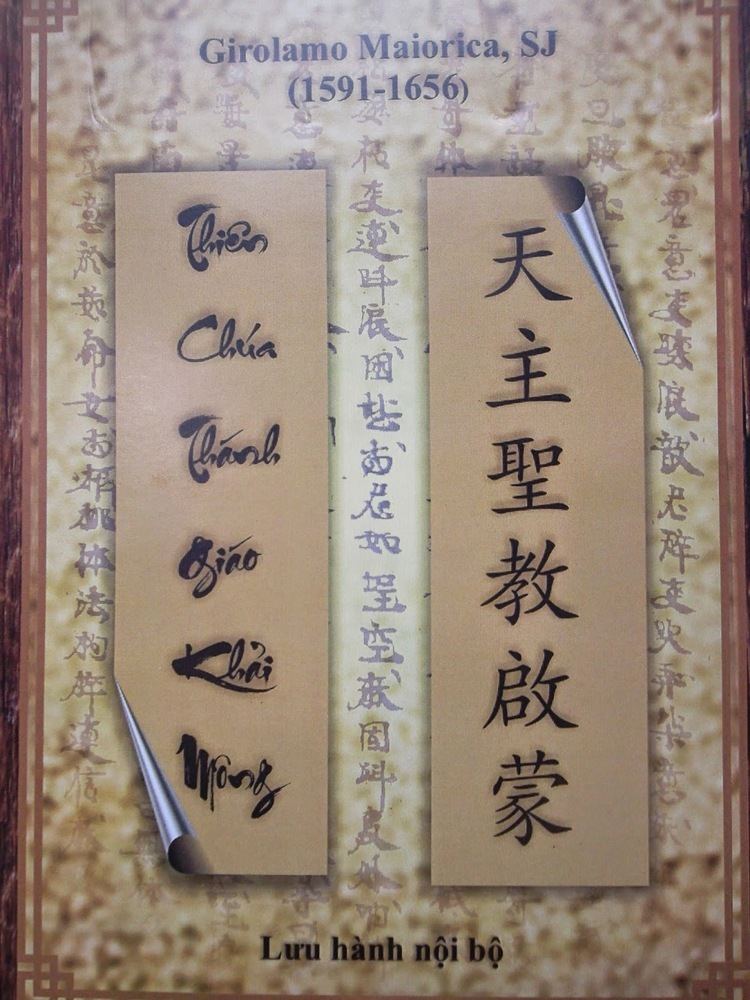Name Girolamo Maiorica | Died 1656 | |
 | ||
Girolamo Maiorica (Portuguese: Jerônimo Majorica; chữ Nôm: 梅烏理哥; Vietnamese alphabet: Mai Ô Lý Ca; 1591–1656) was a 17th-century Italian Jesuit missionary to Vietnam. He is known for compiling numerous Roman Catholic works written in the Vietnamese language's demotic chữ Nôm script, both on his own and with assistance from local converts. Maiorica was one of the first authors of original Nôm prose. His works are seen as a milestone in the history of Vietnamese literature.
Contents
Biography
Maiorica was born in Naples, probably in 1581, 1589, or 1591. He entered the Jesuit order on 19 May 1605. He was ordained a priest by Cardinal Robert Bellarmine in Rome before heading to Lisbon en route to the Far East in 1619.
Maiorica initially stopped in Goa, then arrived in Macau with the intention to proselytize in Japan. However, by 1619, Japan had begun persecuting Christians, so he went instead to Makassar and remained there for a year. Afterwards, he returned to Macau and traveled to Fai-Fo (present-day Hội An) in 1624 in the same boat as Alexandre de Rhodes, João Cabral, and two or three other Jesuits. Whereas de Rhodes studied Vietnamese under Francisco de Pina (1585–1625), Maiorica studied Vietnamese at the Jesuit residence in Nước Mặn (today An Nhơn District, Bình Định Province). He proselytized in Đàng Trong (Cochinchina) from 1628, when his superiors sent him back to Macau en route to a new assignment in Japan. He was again unable to make the journey, this time due to poor weather. In 1630, he traveled to Champa, where he was quickly imprisoned. After a Portuguese merchant ransomed him, Maiorica made his way to Cửa Hàn (Danang) via Cambodia.
On 19 October 1631, he went to Thăng Long (Hanoi) with Bernardino Reggio. The next year, Maiorica and Reggio started a printing press to print copies of Matteo Ricci's Chinese-language work, The True Meaning of the Lord of Heaven, as well as a defense of the faith by Francesco Buzomi. The press was destroyed within several months. Maiorica left Thăng Long for Kẻ Rum, in Nghệ country (xứ Nghệ, present-day Nghệ An), to seek converts in the hinterlands. He stopped writing in the early 1640s to focus on his pastoral duties. In the early 1650s, he returned to Thăng Long to serve as the superior of the Tonkin missionary region. In 1653, he was promoted to provincial of the Jesuits' Japan Province (which included Tonkin, Đàng Trong, Makassar, Cambodia, and Hainan island). Although this province was officially based out of Macau, Maiorica administered it from Thăng Long. In January 1656, he fell ill in Thanh Hóa and died on 27 January 1656 in Thăng Long.
Linguistic influence
All but one of the extant, 17th-century Christian works written in chữ Nôm can be positively attributed to Maiorica. These works are seen as a vital resource for research into chữ Nôm, as well as historical dialects, vocabulary, and phonology of Vietnamese. To translate Catholic theological concepts, Maiorica favored plain, commonly understood vocabulary over Sino-Vietnamese vocabulary, even in cases where the latter would have been consistent with the terms used by his Jesuit colleagues in China. For example, he referred to God as Đức Chúa Trời Đất (literally, "Virtuous Lord of Heaven and Earth") instead of Thiên Địa Chân Chúa and to the Eucharist as Mình Thánh ("Holy Body") instead of Thánh Thể. (Today, Thiên Chúa and Thánh Thể are the preferred terms, respectively.) Many of the terms he chose would later become popular, such as sự thương khó (passion), rỗi linh hồn (salvation of souls), tin kính (to believe, appearing in the creeds), khiêm nhường chịu lụy (humility and submission), hằng sống (eternal life), cả sáng (hallowed, appearing in the Lord's Prayer), etc.
Scholarship
Historians made reference to Maiorica's works as early as the mid-17th century. Not long after he died, two official Jesuit publications, one published circa 1660–1673 and the other in 1676, also listed manuscripts under his name. For nearly three centuries after that, Western scholars paid very little attention to him. Philipphê Bỉnh (Felippe do Rosario), a Vietnamese Jesuit priest who spent his final years in Lisbon, provided additional important information about Maiorica's works. Apart from this, no new details emerged from then until the mid-20th century.
A major milestone in research on Maiorica occurred in 1951 when Jesuit historian Georg Schurhammer published an article regarding three early Christian authors in Vietnam: Maiorica, João Ketlâm (Gioan Thanh Minh), and Felippe do Rosario. However, he was unaware that copies of Maiorica's works remain.
Schurhammer's investigation was of interest to researcher Hoàng Xuân Hãn, who was in Europe at the time and read the article. He coincidentally encountered a set of manuscripts that he considered very likely to have been written by Maiorica. This discovery elicited excitement among Vietnamese historians, and several individuals published transliterated reproductions of these works. In the half century since then, progress has been made in verifying the authenticity of, preserving, transliterating, and publishing Maiorica's works, which once were assumed to be completely lost.
